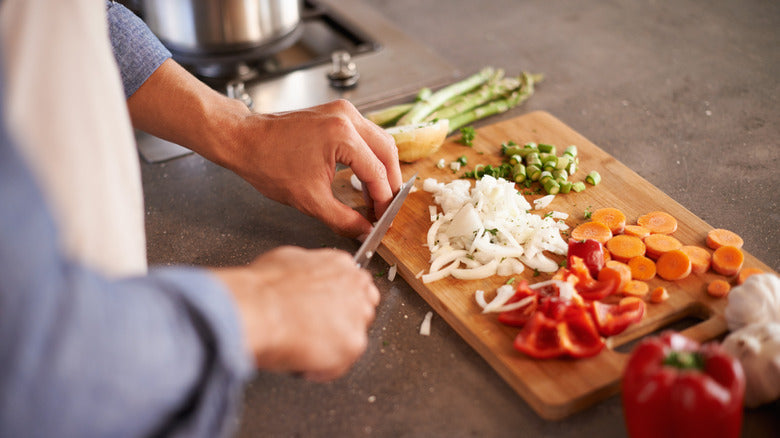As a kitchen professional, you likely understand how essential a clean workspace is for crafting culinary masterpieces. One of the most widely used tools in any kitchenthe wood cutting boardrequires proper care and maintenance to ensure food safety and durability. In this guide, well explore how to sanitize wood cutting board to not only enhance its longevity but also ensure that it remains hygienic for all your food preparation needs.

Why is Sanitizing Wood Cutting Boards Important?
Wood cutting boards naturally trap food residues and bacteria even after rinsing. While wood has some self-healing properties and natural anti-bacterial qualities, its still prone to contamination, especially after handling raw meats, fish, or poultry. Proper sanitation is crucial to minimize the risks of cross-contamination that could lead to foodborne illnesses, ensuring your kitchen remains a hub of health and safety.
Key Benefits of Proper Sanitization:
- Prevents Foodborne Illnesses: A clean board reduces the risk of contracting illnesses caused by harmful bacteria.
- Extends Lifespan: Proper care can enhance your cutting boards durability.
- Better Food Quality: No residual odors or flavors will transfer between ingredients.
Steps: How to Sanitize Wood Cutting Board
To ensure your cutting board is in top condition, follow these tried-and-tested steps:
1. Remove Food Residue
Begin by scraping off leftover food or debris using a scraper or a spatula. This crucial first step lays the foundation for effective sanitizing.
2. Wash with Hot, Soapy Water
Gently scrub the wood surface with a soft sponge and hot, soapy water. Rinse thoroughly to remove all soap residues. This step removes grease and surface bacteria, prepping the board for deeper cleaning.
3. Disinfect the Surface
Use a solution of white vinegar (1:1 ratio with water) or a diluted bleach solution (1 tablespoon bleach mixed with a gallon of water). Avoid soaking as it can cause the wood to warp. Simply apply the solution, let it sit for a few minutes, and rinse thoroughly with running water.
4. Eliminate Stubborn Stains
Sprinkle coarse salt or baking soda onto the cutting board and scrub with a lemon half. This technique is effective for removing stains and deodorizing naturally.
5. Dry Immediately
Pat the board dry with a clean towel and leave it upright to air dry completely. Avoid leaving the board flat as moisture may build up underneath.
How to Maintain Your Wood Cutting Board Long-Term
Beyond regular sanitization, maintaining your wood cutting board is vital to prolong its life. Here are some expert tips:
1. Oil Your Cutting Board Regularly
Use food-grade mineral oil to nourish and protect the wood. Apply it every few weeks or when the board starts to dry out. Heres a simple resource on cutting board care.
2. Avoid Overexposing to Moisture
Refrain from soaking your wood cutting board in water, as this causes warping and cracking. A quick wash and proper drying suffice.
3. Sand Down Splinters
Over time, your board may form small splinters. Use fine-grit sandpaper to smoothen the surface and re-oil it after sanding to restore its texture and shine.
Common Misconceptions About Sanitizing Wood Cutting Boards
There are a lot of myths surrounding the maintenance of wooden cutting boards. Lets debunk some of them:
- Myth #1: Wooden cutting boards trap bacteria more than plastic ones. Fact: Studies show wood fibers can kill certain bacteria trapped within the grain.
- Myth #2: Dishwashers can safely clean wood boards. Fact: Heat and extensive water exposure will damage wood.
- Myth #3: Oil products like olive or vegetable oil help protect your board. Fact: These oils soften the wood and can turn rancid over time.
FAQs About How to Sanitize Wood Cutting Board
How often should I sanitize my wood cutting board?
You should sanitize your wood cutting board after every use, especially if youve handled raw meat, fish, or poultry.
Can I use dish soap alone to clean wood cutting boards?
While dish soap removes surface debris, a deeper clean is required to kill bacteria, such as applying a vinegar or bleach solution.
What is the best oil for wood cutting boards?
Food-grade mineral oil is the safest and most effective oil for preserving wooden cutting boards.
Are all wooden cutting boards the same?
Different types of wood offer unique benefits, but end-grain cutting boards are excellent for durability and keeping knife edges sharp.

Conclusion
Knowing how to sanitize wood cutting board is a vital skill for kitchen professionals. By following these simple yet effective maintenance tips, youll ensure that your board remains clean, safe, and long-lasting. For more information on cutting board hygiene, visit cutting board hygiene tips.
This article contains affiliate links. We may earn a commission at no extra cost to you.






Leave a comment
This site is protected by hCaptcha and the hCaptcha Privacy Policy and Terms of Service apply.